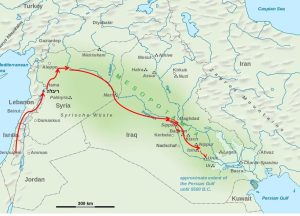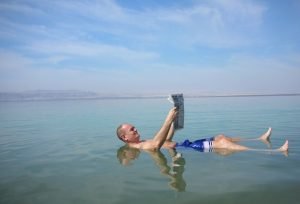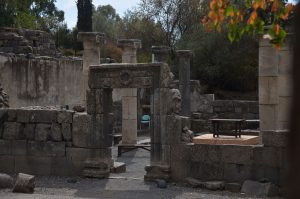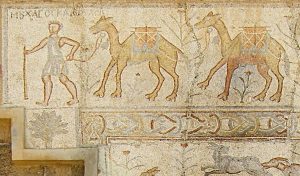Our world is hyper-connected. You can go online and in a moment you can hear statements said thousands of miles away. But even in ancient times, people needed to know what was being discussed and decided elsewhere. The news was carried not by Whatsapp or Twitter but by travelers. Ravin is one of those travelers:
“And similarly, when Ravin came [from Eretz Yisrael to Babylonia], he said that Rabbi Ilai says: The halakha is that one writes a receipt.” (Bava Batra 171b)
The context here is a dispute between Rav and Shmuel, Babylonian amoraim, on the one hand, and Rabbi Yohanan and Resh Lakish, Eretz Yisrael amoraim on the other. Ravin arrives to confirm the halacha as taught in the Land of Israel. Ravin was part of a tradition of people called nehutei נחותי , those who descend (going from Israel to Babylonia is a descent, physically and spiritually). Various phrases clue us in to the nehutei’s presence: כי אתא, when he came, שלחו מתם a message was sent from there (BB 165b) or simply אמרי במערבא, as they say in the West (Israel).
“Rav Yosef, and some say it was Rabba, would announce: Those that ascend [to Eretz Yisrael from Babylonia,]as well as those that descend [to Babylonia from Eretz Yisrael,], all agree to the following halakha.” (Bava Kamma 23b)
The Land of Israel was the cradle of the Oral Law and the Mishnah was taught and redacted there. Scholars came to study in the academies of Zippori and Tverya, under the tutelage of the great Tannaim. When Rabbi Judah the Prince taught, his students included Hiyya and his nephew, Rav, from Babylonia (see here). Eventually Rav returned home and opened his own academy, as did his contemporary Shmuel. As time passed and life became harder in the Land of Israel, the Babylonian academies eclipsed those of Eretz Yisrael. But Israel retained her primacy and still contained great scholars. The teachings of each of these centers had to be passed from one to the other. Thus were created the nehutei, rabbis on the road whose job was to hear Torah from the source and pass it on to the other center.
“When Ravin and all those descending [from Eretz Yisrael] came [to Babylonia,] they stated this halakha of Rabbi Yoḥanan” (Hullin 124b)
Travel from Israel to Babylonia went through the Fertile Crescent, not across the desert. It was a journey of about 1500 kilometers that took about two weeks. It was not attempted alone but in the company of a caravan of travelers. Despite the dangers and the expense, it seems that travel on this route was fairly frequent.

Key maker, CC BY-SA 4.0 <https://creativecommons.org/licenses/by-sa/4.0>, via Wikimedia Commons
When you start to notice the travelers, the same names pop up over and over. They are prominent in the second to fourth generations of the Amoraim (250 CE – 350 CE). The most common ones are Ulla, Rav Dimi and our friend Ravin. They would go back and forth, refreshing the teachings if there had been a change. Often the person they are quoting is Rabbi Yohanan.
“And our colleagues who descended from Eretz Yisrael; and who is the Sage with this title? Ulla said in the name of Rabbi Yoḥanan” (Berachot 38b)
Besides passing on teachings, sometimes the travelers had to inform the Babylonians of the calendar, which could only be determined in the Land of Israel:
“When Ulla came [from Eretz Yisrael to Babylonia,] he said: They sanctified the New Moon in the West,” (Rosh HaShanah 22b)
Rav Dimi and Ravin came after Ulla. Sometimes in the course of traveling, mistakes were made or information became outdated:
“When Rav Dimi ascended to Neharde’a, he sent to the yeshiva students: The statements I said to you, they are my mistake. However, this is what they said in the name of Rabbi Yoḥanan” (Shabbat 63b)
A fascinating part of these traveler accounts is that sometimes they were doubted. After all if you have never seen the Dead Sea, would you believe an account of its unusual properties?
“When Rav Dimi came from Eretz Yisrael to Babylonia he said: No person has ever drowned in the Sea of Sodom, Rav Yosef said: Sodom is overturned and Rav Dimi’s statement is backward. a man does not drown in the Dead Sea, but a plank sinks?” (Shabbat 108b)

aka4ajax, CC BY 3.0 <https://creativecommons.org/licenses/by/3.0>, via Wikimedia Commons
Ravin is often mentioned in conjunction with Rav Dimi. Did they travel together or did they tag-team, one arriving in Israel as the other departed for Babylonia? It is unclear if Ravin was born in Israel or in Babylonia but he certainly spent time in both places. Like modern cosmopolitan people, he had different names in different places. The Talmud Bavli calls him Rabbi Avin, or that name’s short version, Ravin. The Yerushalmi takes off the “A” and calls him Rabbi Bun. As a very young man he met Rabbi Yohanan and Resh Lakish, as we see in this story:
“Rabbi Avin is the one who went, and he said: The entire coterie sided with the Rabbi Yoḥanan. And Reish Lakish screamed like a crane” (Kid 44a)
Much of Ravin’s knowledge of Rabbi Yohanan comes from having studied under the latter’s students: Rabbi Abahu, Rabbi Zeira and Rabbi Ilai. Ravin’s word was considered more reliable than some of the other nehutei:
“Avin is reliable but Yitzḥak the Red is not reliable? Avin returns [to Eretz Yisrael] Yitzḥak the Red does not return” (Yevamot 64b)
Rashi explains that returns in this context means that he goes back to Rabbi Yohanan and hears if he has changed his mind about his teachings, so that he can bring the updated Torah to Babylonia.
Did Ravin stay in Babylonia at the end of his life or return to the Land of Israel? There is an inscription that was discovered in the Golan town of Katzrin that reads רבי אבון משכבו כבוד, Rabbi Avun, may he rest in honor. One archaeologist suggests that this is the grave of our Rabbi Avin, AKA Ravin. Is it?

Ancient synagogue in Katzrin
רותם אמרגי, CC BY-SA 3.0 <https://creativecommons.org/licenses/by-sa/3.0>, via Wikimedia Commons
By the late fourth century CE, life in the Land of Israel had become more difficult and unstable and the tradition of travelers stops. From that point on, although the academies still existed in Israel, Babylonia was the main center of learning, until it too was eclipsed by other places.
The Middle East is being reshaped before our eyes these days. Will there come a time when we can freely travel between Israel and Iraq, i.e., Babylonia? We can only hope.

Jadd Haidar, CC BY-SA 4.0 <https://creativecommons.org/licenses/by-sa/4.0>, via Wikimedia Commons










